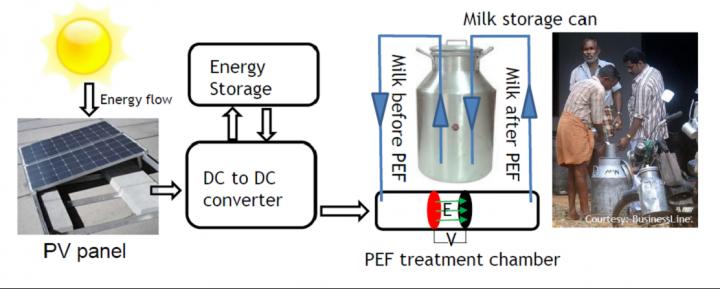Milk is a key element for household food security and provides a stable income to farmers including women, who are usually in charge of taking care of the milk-producing animals in the low-income countries. Currently pathogen growth in milk is managed with refrigeration or with chemicals.
Although bacterial growth in milk is managed with refrigeration in the high-income countries, a high cost of infrastructure and a demand for a permanent electricity supply prevent milk refrigeration in the rural areas in the low-income countries.
Moreover, certain pathogens, for example Listeria monocytogenes, are less sensitive to low temperature; therefore, they can proliferate at refrigeration during transportation and storage.
"There is a constant search for new, low-cost, chemical-free technologies for milk preservation, especially for the small farmers in the low-income countries," says Alexander Golberg, PhD of Porter School at TAU, the paper's author.

How milk is preserved using energy efficient pulsed electric field processing. Credit: TECHNOLOGY
"In many rural places refrigeration is not possible and its alternative, lactoperoxidaze system may be misused to disguise milk produced under poor hygienic conditions as Codex Alimentarius. This development not only holds great promise for unraveling many aspects of the complex wound healing process but can also potentially lead to new therapies," Golberg says, " We believe that this model will enable other laboratories to learn and uncover new aspects of adult tissue growth and development."
Pulsed electric fields is an emerging technology in the food industry. It was shown in multiple studies to effectively kill multiple food born microorganisms and could provide an alternative, non-thermal pasteurization process.
"In the storage application, developed in this work, we use the fundamentally different approach for microorganisms control. Refrigeration, the major milk preservation technology, slows the bacteria metabolism, pulsed electric fields kill them." Alex Golberg says. " Moreover, Our model shows that pulsed electric fields preservation technology does not require a constant electricity supply and can be powered 5.5 hours a day using small, family scale solar panels. I believe that this technology can provide a robust, simple and energy-efficient milk preservation system that would decrease the wasted milk thus increasing the income of the small farmers in developing countries."




Comments